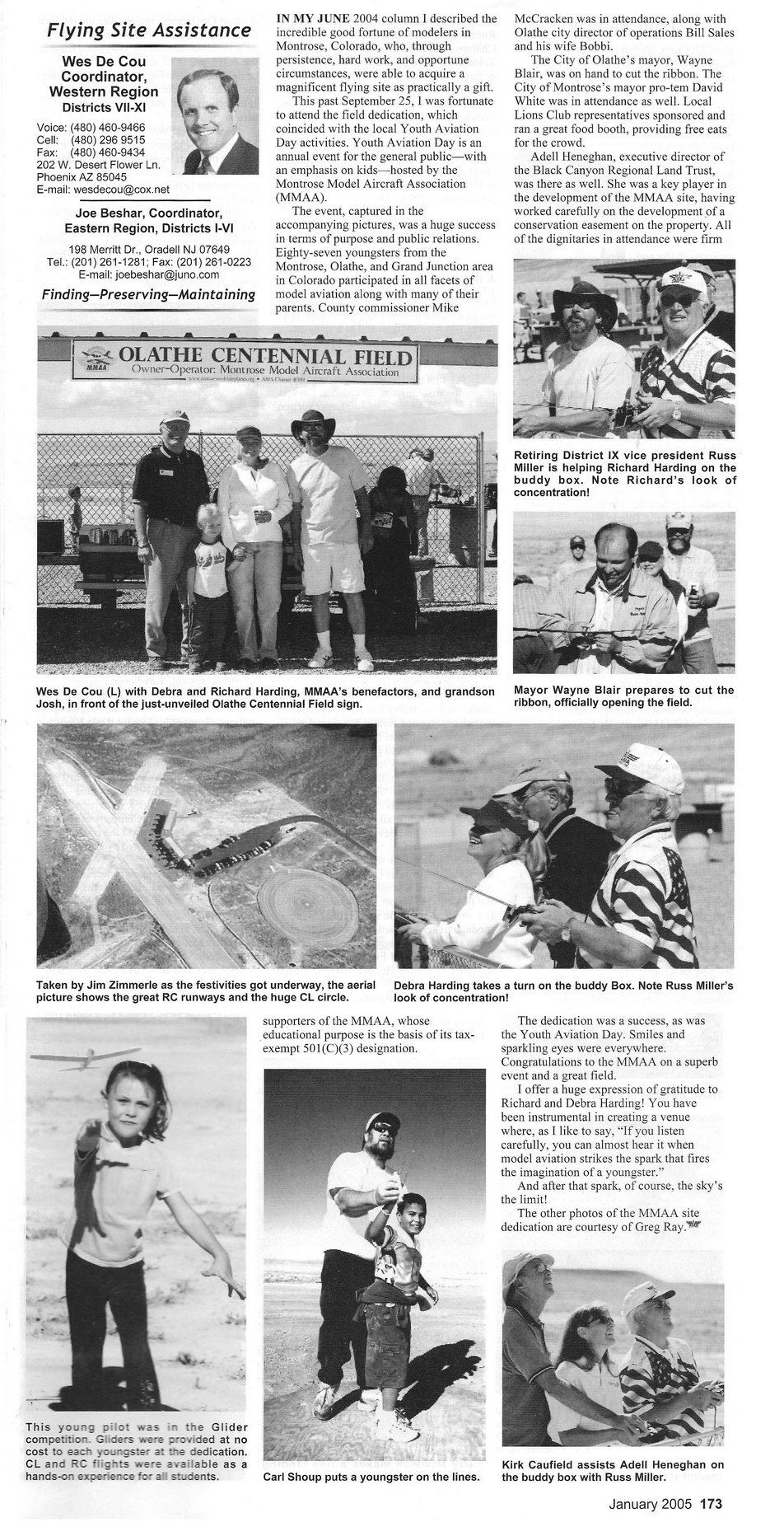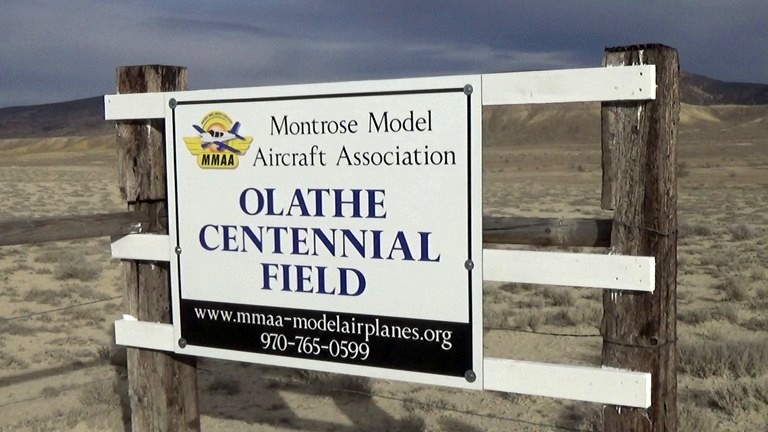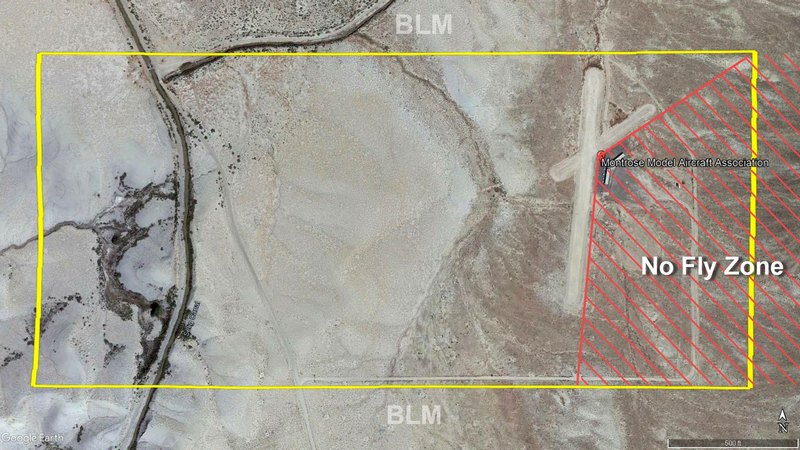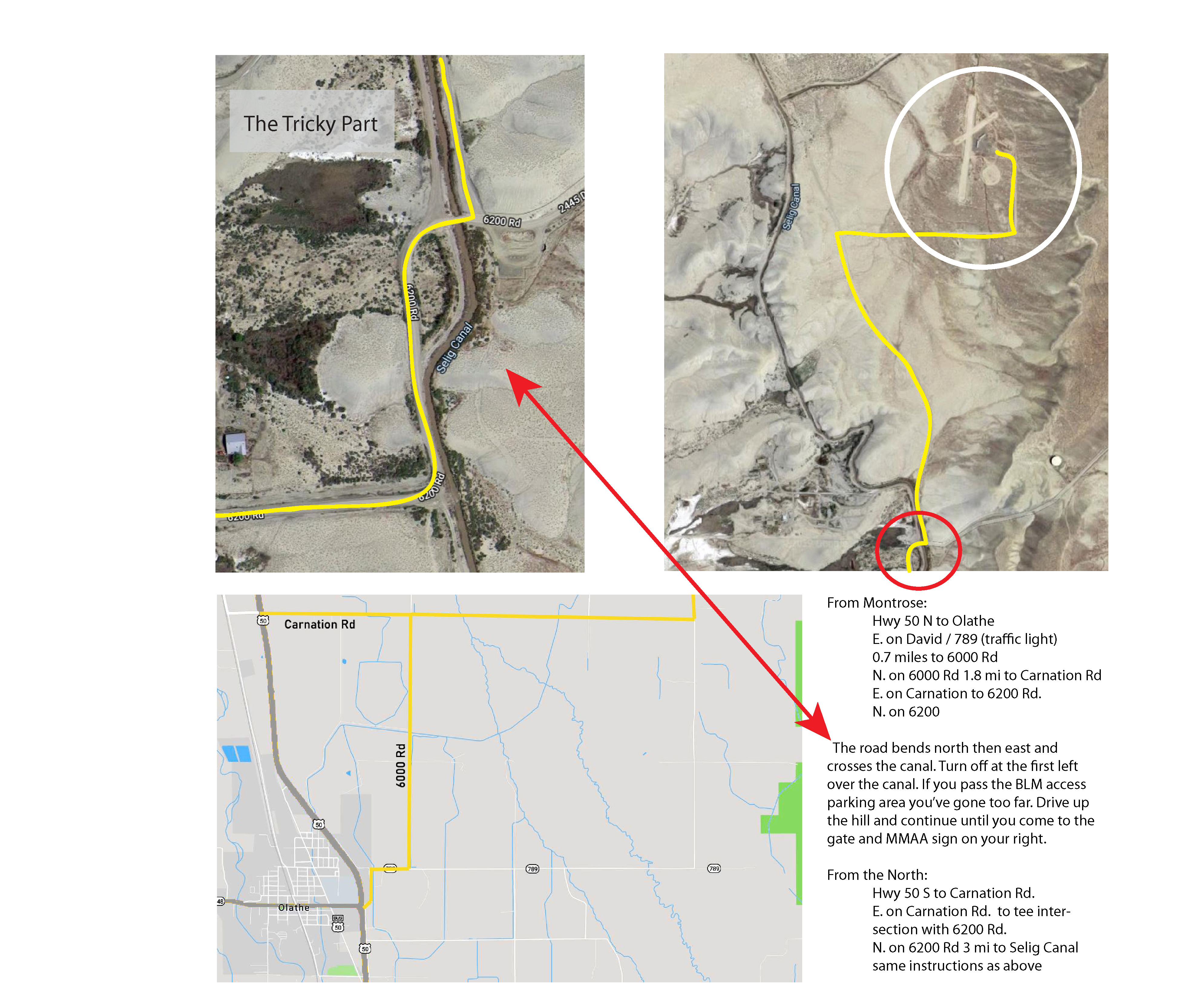Our History
The Montrose Model Aircraft Association (MMAA) is a tax exempt organization which owns its own flying site. It all began in 1971 when the Montrose Mini-Flyers was formed by a loose group of twelve modelers. The Mini Flyers first flying site had a major county road to the west and an airplane eating canyon to the east. Over the next 26 years, triggered by vandalism, and increasing development pressure, the club moved from one location to another.
The current name of Montrose Model Aircraft Association (MMAA) was adopted, corporate papers filed, and tax exempt status granted in March of 1996. AMA sanction was obtained in 1997.
In 1996, an informal lease on private land south of Montrose was obtained. This was a scenic location, with no obstructions, airplane eating hills, or canyons. The search for another more permanent site continued. At that time members developed a vision for the club that included education, community involvement and a first class facility.
MMAA’s Mission Statement stresses an emphasis on educational activity in the community, as well as within the association, and welcomes model aviation enthusiasts of all ages and interests. By the year 2000 the membership had grown to over fifty, largely sport flyers, with participation in radio control, free flight, and control line. Since 1998, basic model building classes have been offered through the Montrose Recreation District. Educational activities have also been conducted at after school venues, juvenile detention facilities, and other locations. MMAA also established an RC pilot training program. With the help of an anonymous donor, donations from Partners, Delta Montrose Electric Association, and MMAA members a model aviation academy, targeted primarily toward “at risk” children was initiated in 2004.
In 1997, MMAA held its first annual Youth Aviation Day, offered to local “at risk” children in cooperation with the local Partners organization. This annual event has been expanded to offer the experience of flying a radio controlled airplane to Foster Children and other local youth. By 2003, nearly one hundred children attended the event. During a typical day the children fly an RC model, are given basic instruction in what makes an airplane fly, and given a balsa glider which they use to participate in a contest. Each child and parent or senior partner are provided lunch and drinks, and each child also wins some kind of aviation related prize, ranging from small dollar toys, to flying electric models. The full size aviation community participates, with fly by’s of a Bell 47 helicopter, an Air Tractor, a Varga Kachina, a Long-Eze, Smith Miniplane, and a Stemme motor glider. The audience is provided with a commentary on the name, origin, use, and specifications for each aircraft. We have also had a full size sailplane and ultra-light aircraft on site. Photos of this event can be found in the photo archive section of the MMAA web site.
In 1997, Montrose County partnered with MMAA to locate and establish a “permanent” facility through a Recreation and Public Purposes Act lease with the U.S. Department of Interior, Bureau of Land Management (BLM). The ensuing public controversy caught MMAA by surprise. It appeared that no support was forthcoming from the community. Attempts to work with citizens groups to find an acceptable alternative site made no progress. In the midst of all of this a local resident, Richard Harding, approached the MMAA and offered to sell MMAA an 83 acre private parcel completely surrounded by public lands. As it happened, populations of a plant listed as Endangered by the Federal Government were discovered on the property. One or two Association members, as well as Mr. and Ms. Harding felt that the plant presented an opportunity, rather than a liability, and began to pursue a conservation easement on the property. Included in this proposal would be the protection of the endangered plant (the clay loving wild buckwheat, Eriogonum pelinophilum) and its environment, construction of a model airplane flying site, and construction of an outdoor earth science facility for the local schools.
Those involved with MMAA were surprised when community opposition to the original proposal, west of Olathe, carried over to this site as well. There were complaints about potential trash, traffic, noise, damage to the environment, and so on. Through persistent efforts of MMAA and the Hardings, all the issues were resolved.
Permits from Montrose County were obtained for the construction and operation of the flying site in 2002, and by 2003 conservation easements for both forty acre parcels were completed. The tax benefits and other compensations from these easements offset Mr. and Ms. Harding’s debt on the parcel. By the spring of that year construction of Olathe Centennial Field began.
MMAA is fortunate in receiving support from: the Colorado Department of Transportation (recycled cabanas, guard rail, and other materials), community members (equipment and personal time), Blueline Engineering (surveying and design), Delta Montrose Electric Association (grants), AMA (grants and other support), and the former property owners. Photos of work crews, and field development projects can be found on this the photo gallery on this web site.
On the Centennial of Flight in 2003, Mr. Harding and his wife Debra signed a quit claim deed to 40 acres of the property transferring title to MMAA for a ten dollar fee. In November of 2005, Mr. and Ms. Harding transferred the remaining 43 acres. This put MMAA in the unique position of owning a facility surrounded by public land (see the Flying Site Assistance articles in the June 2004 and February 2005 issues of Model Aviation Magazine for more information). The Association remains indebted to the generosity of Ms. and Mr. Harding.
The vision of its members has carried the Association toward a future of educational activities, community involvement, security, and participation in the facets of Model Aviation that its members enjoy.
Article from January 2005 Model Aviation magazine:

Links
MMAA on Facebook Post your photos, stories and comments
Academy of Model Aeronautics
The national organization representing and supporting model aviation and its participants. AMA also provides members and clubs with liability insurance. The monthly magazine, Model Aviation, covers the entire range of interests for those participating in the hobby.
Hobby Hut
Local Hobby Store Grand Junction
For Sale
GJ Modeleers
Grand Junction Flying Club and Field
RC Field Etiquette
Do's and Don'ts while out there having fun
The Complete E-Power System by Tom Hunt
A good basic description of how to choose all the basic components of an electric power system to insure success. Some of the material is a little dated, but the advice is very relevant. A good reminder for even for those of us who have been doing this for a while.
YouTube Showcase
Showing aerial views of the site, people, planes and action.
A Natural Resource Inventory of the Uncompahgre River Basin, Montrose and Ouray Counties
A lengthy, somewhat technical report, by the Colorado Natural Heritage Program that provides an overview of the various native plant/animal communities within the Uncompahgre River Basin in Montrose and Ouray Counties. The MMAA property and it's surroundings are included within the report area. You will find a bit of information on the endangered clay-loving wild buckwheat that is found on our property.
If you really want to find out about the biological resources, and to some extent the non-living portions of the native ecosystems, this is a good start.
Fish and Wildlife Service Information for the Clay Loving Wild Buckwheat
All the information you could want regarding the endangered clay-loving wild buckwheat plants that are present on MMAA property and the adjacent BLM lands. This plant's presence on our property enabled the prior owner to establish a conservation easement on the property, and ultimately allowed MMAA to purchase the property for a literal song.
Airfoil Tool
Airfoil search, airfoil plotter, airfoil comparison, airfoil generators, lift/drag polars, and Reynolds number calculator. You can even add your own airfoil into the system to make use of the tools present on this site. this site contains some of the data you can find on UIUC's airfoil site, but with a different kind of utility. Lots to learn here, and to make direct use of if you are designing something of your own, or are simply wanting to know more about the airfoil on your latest acquisition.
UIUC Airfoil Coordinates Database
An incredibly complete listing of airfoils, including .dat files, GIF files for each airfoil, and additional links to tons of helpful information about specific airfoils and airfoils in general. There links to .dxf files for those CAD users reading this. Even if you don't plan to design your own wings, there is a wealth of information presented here including a good bit of material from Professor Michael Selig.
The Outerzone
A source for free plans of all types, FF, UC, and RC. All plans have been published in the past. Some are for models that were manufactured at one time like the Sig 29er, Wanderer sailplane, Lil Jumping Bean control line stunter, etc. All plans are downloadable and of good quality. A good browse for anyone.
League of Silent Flight
A special interest site for all RC sailplane enthusiasts.
RC Soaring Digest
A monthly online soaring magazine. Sailplane news from around the world. Build threads, aerodynamics articles, contest information, etc. A good read for non-sailplane types too.
Modern Lift Equation NASA provides a good review
Cars Tanks and Airplanes of WWII Information and additional links within.
Full Size Plans Model Classics including Full Size Plans
MMAA Calendar
Know Before You Fly
Currently, small unmanned aircraft systems (sUAS) may be operated for hobby and recreational purposes under specific safety guidelines as established by Congress. Small UAS flown for recreational purposes are typically known as model aircraft.
Under the Special Rule for Model Aircraft, recreational UAS must be operated in accordance with several requirements, including a community-based set of safety guidelines and within the programming of a nationwide community-based organization such as the Academy of Model Aeronautics (AMA). Operators not operating within the safety program of a community-based organization should follow the FAA’s guidance here.
As of Dec. 21, 2015, the Federal Aviation Administration requires all owners of small unmanned aircraft, or drones, weighing between 0.55 and 55 pounds to register online before taking to the skies.
What is recreational use of sUAS?
The recreational use of sUAS is the operation of an unmanned aircraft for personal interests and enjoyment. For example, using a sUAS to take photographs for your own personal use would be considered recreational; using the same device to take photographs or videos for compensation or sale to another individual would be considered a commercial operation. You should check with the FAA for further determination as to what constitutes commercial or other non-hobby, non-recreational sUAS operations.
What are the safety guidelines for sUAS recreational users?
Follow community-based safety guidelines, as developed by organizations such as the Academy of Model Aeronautics (AMA).
Fly no higher than 400 feet and remain below any surrounding obstacles when possible.
Keep your sUAS in eyesight at all times, and use an observer to assist if needed.
Remain well clear of and do not interfere with manned aircraft operations, and you must see and avoid other aircraft and obstacles at all times.
Do not intentionally fly over unprotected persons or moving vehicles, and remain at least 25 feet away from individuals and vulnerable property.
Contact the airport and control tower before flying within five miles of an airport or heliport. (Read about best practices here)
Do not fly in adverse weather conditions such as in high winds or reduced visibility.
Do not fly under the influence of alcohol or drugs.
Ensure the operating environment is safe and that the operator is competent and proficient in the operation of the sUAS.
Do not fly near or over sensitive infrastructure or property such as power stations, water treatment facilities, correctional facilities, heavily traveled roadways, government facilities, etc.
Check and follow all local laws and ordinances before flying over private property.
Do not conduct surveillance or photograph persons in areas where there is an expectation of privacy without the individual’s permission (see AMA’s privacy policy).
Users of commercial and recreational UAS should be aware that in remote, rural and agricultural areas, manned aircraft, including fixed-wing aircraft and helicopters, may be operating very close to ground level. Pilots conducting agricultural, firefighting, law enforcement, emergency medical, wildlife survey operations and a variety of other services all legally and routinely work in low-level airspace. Operators controlling UAS in these areas should maintain situational awareness, give way to, and remain a safe distance from these low-level, manned airplanes and helicopters.
For more safety information, please download the Know Before You Fly brochure here.
LiPo Management
“Is my LiPo battery safe to use?”, “How do I know if my LiPos are damaged beyond repair?”, and “How long will my LiPo batteries last?”
There is one underlying concern: Safety.
What Causes Puffing or Swelling in LiPos
You may have heard people tell you to discharge and properly dispose the LiPo if it starts to puff up. While partially correct, all LiPos will inevitably show some degree of swelling. Why do LiPos puff up?
A LiPo battery is made of three main components: the positive electrode (cathode), the negative electrode (anode), and the liquid electrolyte. Electrolyte is a chemical inside your LiPo that enables the flow of ions from the negative end to the positive end during discharge, and vice versa when charging.
Your LiPos puff up due to a naturally occurring phenomenon known as electrolyte decomposition. When electrolyte decomposes, hydrogen, carbon dioxide, and carbon monoxide are formed as by-products. These gases are not only responsible for the physical swelling of your LiPos, but two of the three are also highly flammable.
Electrolyte decomposition will occur regardless of how you handle your LiPos. So, going back to our first question, should you dispose of your LiPos if they start to swell up? The correct answer is - it depends. When properly cared for and used responsibly, electrolyte decomposition will still take place, however, at a much slower rate. If you only had your LiPo for a brief period and it swells up exponentially, then you are either doing something wrong, or the LiPo could be faulty - under this scenario, we will recommend you safely dispose of it.
On the other hand, if your LiPo has gone through 50+ cycles and starts to show some swelling, we would consider this to be perfectly normal and would not recommend you retire it just yet. In theory, a swollen LiPo can still be fairly safe to use if everything else is intact and working properly. As noted, two of the three gases – hydrogen and carbon monoxide – are highly flammable and can become dangerous if there is a heat spike, or if exposed to air; both can be attributed to external factors which will be discussed below.
Physical Signs of Damage
One of the first and most obvious ways to determine if your LiPos are safe to use is to physically examine them. A physically damaged LiPo, combined with swelling is really just a ticking time bomb. Most, if not all LiPo accidents happen for one reason: a punctured inner foil. When punctured and exposed to air, the mixture of gases and lithium ions will ignite and even explode.
After every use, check your LiPos for any glaring impairments. If you just came out from a hard landing with your RC aircraft or completed a bumpy ride on your basher, pay extra attention to surface dents, deformities, cracked wraps, wrinkled cells, and any damages to the battery connectors.
Internal Resistance
One of the best and more accurate ways to determine if your LiPo is functioning properly or not is to check the internal resistance (IR). IR ultimately dictates how efficient your battery is. A low IR implies greater efficiency while a high IR means the opposite. Just like electrolyte decomposition, IR will gradually increase over time, however, proper usage can significantly prolong the process.
A high IR will cause your LiPos to heat up very quickly while delivering a lower voltage; in layman’s terms, it would mean that your LiPo is working two times harder while only delivering half of the results. Continued usage of a LiPo with a high IR will ultimately cause it to heat up and expand to a certain point where one of the inner cells may rupture causing it to explode.
When you first purchase your LiPo measure its IR. Generally, an increase of around 80-90% would indicate that your LiPo is nearing its end and you should probably dispose of it. So, for example, if you had an initial IR of 10 mΩ and after 150+ cycles the IR reads at 18 mΩ, this would suggest that your LiPo should be retired sooner rather than later.
In Conclusion...
As with most things, nothing is ever 100%. However, next time you reach the crossroad of deciding whether your LiPo is near its end or not, you could use these simple steps:
1. When you first purchase your LiPo, label it with the date of its first use. Using this date, you can gauge if the swelling is proportionate to its usage. Generally, HobbyKing’s LiPo batteries can last 2-3 years on average.
2. Check for any obvious damages that may be detrimental to the inner wrapping of the cells. This may include, but not limited to the following: surface dents, deformities, cracked wrapping, wrinkled cells, and damaged battery connectors.
3. Using a smart charger or battery meter, check that the IR is not overly high. Even if only one of your three cells has an off rating, discontinue using it as any rupture to any of the cells can lead to a major disaster.




























































































































































